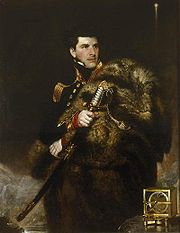
Dip circle
Encyclopedia

Horizon
The horizon is the apparent line that separates earth from sky, the line that divides all visible directions into two categories: those that intersect the Earth's surface, and those that do not. At many locations, the true horizon is obscured by trees, buildings, mountains, etc., and the resulting...
and the Earth's magnetic field
Earth's magnetic field
Earth's magnetic field is the magnetic field that extends from the Earth's inner core to where it meets the solar wind, a stream of energetic particles emanating from the Sun...
(the dip angle). They were used in surveying
Surveying
See Also: Public Land Survey SystemSurveying or land surveying is the technique, profession, and science of accurately determining the terrestrial or three-dimensional position of points and the distances and angles between them...
, mining
Mining
Mining is the extraction of valuable minerals or other geological materials from the earth, from an ore body, vein or seam. The term also includes the removal of soil. Materials recovered by mining include base metals, precious metals, iron, uranium, coal, diamonds, limestone, oil shale, rock...
and prospecting
Prospecting
Prospecting is the physical search for minerals, fossils, precious metals or mineral specimens, and is also known as fossicking.Prospecting is a small-scale form of mineral exploration which is an organised, large scale effort undertaken by mineral resource companies to find commercially viable ore...
as well as for the demonstration and study of magnetism
Magnetism
Magnetism is a property of materials that respond at an atomic or subatomic level to an applied magnetic field. Ferromagnetism is the strongest and most familiar type of magnetism. It is responsible for the behavior of permanent magnets, which produce their own persistent magnetic fields, as well...
.
Georg Hartmann
Georg Hartmann
Georg Hartmann was a German engineer, instrument maker, author, printer, humanist, churchman, and astronomer....
first discovered dip angle in 1544, when he noticed the needle on a compass
Compass
A compass is a navigational instrument that shows directions in a frame of reference that is stationary relative to the surface of the earth. The frame of reference defines the four cardinal directions – north, south, east, and west. Intermediate directions are also defined...
dipped towards the north hemisphere
Northern Hemisphere
The Northern Hemisphere is the half of a planet that is north of its equator—the word hemisphere literally means “half sphere”. It is also that half of the celestial sphere north of the celestial equator...
. Rather than explore this phenomenon, Hartmann sought ways to eliminate it. However, Robert Norman
Robert Norman
Robert Norman was a 16th century-English mariner, compass builder, and hydrographer who discovered magnetic inclination, the deviation of the Earth's magnetic field from the vertical.- Work :...
around 1576 investigated dip angle further and in 1581 described in print a device to measure this phenomenon.
Early dip circles were not accurate and gave poor results. Over the next 300 years many improvements were made, including reducing the friction
Friction
Friction is the force resisting the relative motion of solid surfaces, fluid layers, and/or material elements sliding against each other. There are several types of friction:...
between the needle and its pivot and encasing the circle in glass. Between the late 18th century and late 19th century the design approached its peak. Improvements which made the dip circle a practical aid for polar navigation were made by Robert Were Fox
Robert Were Fox the Younger
Robert Were Fox FRS was a British geologist, natural philosopher and inventor. He is known mainly for his work on the temperature of the earth and his construction of a compass to measure magnetic dip at sea....
FRS, who developed in the 1830s the first dip circle that could be used on board a moving ship. Another important improvement to the instrument was developed in the 1830s by the Dublin Physicist Humphrey Lloyd, who devised a way of attaching a magnetic needle at right-angles to the dip needle in order to measure the intensity of force
Force
In physics, a force is any influence that causes an object to undergo a change in speed, a change in direction, or a change in shape. In other words, a force is that which can cause an object with mass to change its velocity , i.e., to accelerate, or which can cause a flexible object to deform...
(by seeing the extent to which the right-angle needle deflected the dip-needle).
By World War I
World War I
World War I , which was predominantly called the World War or the Great War from its occurrence until 1939, and the First World War or World War I thereafter, was a major war centred in Europe that began on 28 July 1914 and lasted until 11 November 1918...
the most advanced dip circles were being made. With the development of electronic systems dip circles became obsolete.

